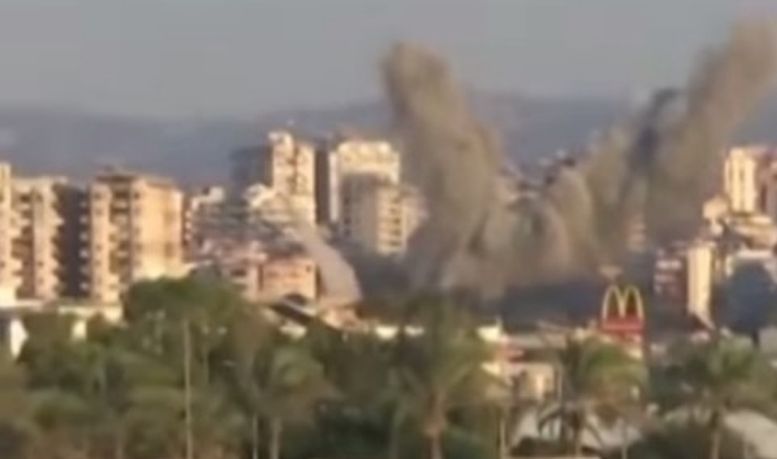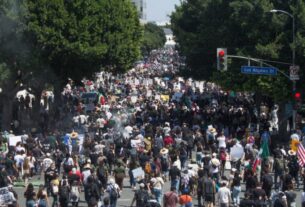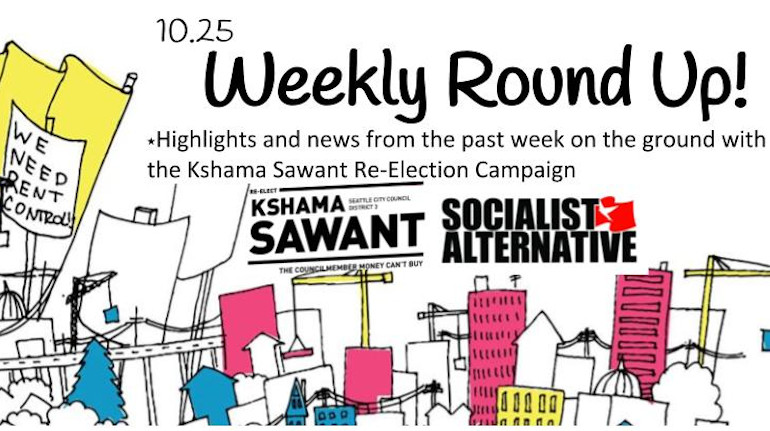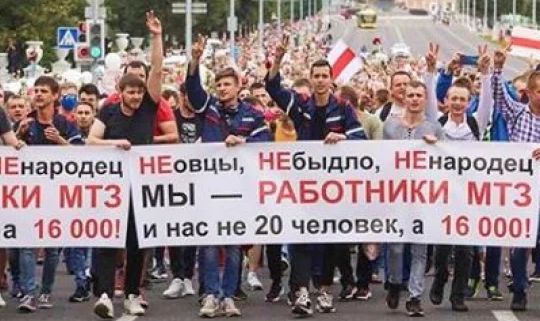The onslaught of assassinations and bombings in Lebanon is pushing the entire Middle East into the abyss of a regional war. Now with the Israeli invasion of Lebanon and Iranian missiles fired at Israel, on top of the massive bombings in Beirut and the assassination of the secretary general of Hezbollah, Hassan Nasrallah, signifies a new peak in the direction of an all-out war on Lebanon, on the brink of a regional war. Mobilization for the struggle is needed to stop more disasters on a historic scale
The historic bloody crisis, which began almost a year ago, is now entering a new phase — closer than ever to a regional war. The attack on Hezbollah’s central headquarters in Dahieh in Beirut — which included the destruction of at least 6 residential buildings and a horrific massacre with hundreds of deaths according to some reports — is the culmination of the ‘shock and awe’ war that the Israeli regime launched about 10 days ago on Lebanese soil with the aim of changing the balance of forces in the entire Middle East against the Iranian regime and its allies.
The extensive state terror campaign, that includes the killing of more than 700 people in Lebanon in the last few days, and bombing of residential buildings in Beirut, brings millions in Lebanon within the range of fire, and not only does it not promote the return of the Israelis residents of the north to their homes — it brings about a reality in which millions more on the Israeli side of the border come into the firing range of Hezbollah, combined with the increase of firing by militias from Iraq and Yemen.
“This is an all-out war. What Israel has done in the last two weeks and yesterday is enough to ‘close the door’ to any kind of settlement. Lebanon and the entire region have entered a new phase of conflict that will lead to a change in the face of the region” was written on Saturday, In the Lebanese newspaper “Al-Akhbar” which is identified with Hezbollah.
“New Order”
The target of the attack in Beirut on Friday evening, during which several residential buildings were leveled with the residents inside, with more than 80 bombs with an average weight of one tonne, was the assassination of Hassan Nasrallah — the military and political leader of Hezbollah and de-facto of the pro-Iranian “axis of resistance” in the region. Nasrallah was both the public face and the strategist of the “Axis” and the consequences of his assassination will also be different to the provocative demonstrative assassinations of Fuad Shukr (Haj Mohsein) and Ismail Haniyeh at the end of July.
The New York Times quoted on Saturday, an Israeli senior official that said that the attack in Dahieh was intended to “break Hezbollah” by assassinating senior commanders in the organization. The Israeli regime is trying to break the Hezbollah militia, the strongest link in the chain of militias of the ‘Axis of Resistance’, to break the entire axis. This cannot happen without an extensive regional conflict, which is prolonged and destructive. Symbolically the Israeli military chose to call the Nasrallah assassination attack “New Order”.
The assassination in 1992 of Abbas al-Musaw, the former secretary general of Hezbollah, and in 2008 of Imad Mughniyeh, the former head of the organization’s military wing, did not prevent Hezbollah and the ‘Axis of Resistance’ from continuing to strengthen militarily over the years. Likewise, the assassination of Nasrallah in itself will not shape the region according to the wishes of Netanyahu, Gallant and the generals in the Israeli army.
Before the assassination, on Wednesday night, the cabinet of death authorized Netanyahu and Gallant to approve a ground invasion of Lebanon. This means that they can legally order the initiation of such a ground attack at any time. The Israeli senior official Quoted in the New York Times said that if the assassination of the Hezbollah leadership succeeds, it “will allow Israel to avoid ground entry into Lebanon”. But the opposite is true. Taking the Hezbollah militia off balance by assassinating its commanders thwarts any attempt to reach an agreed arrangement on the border, urges Hezbollah to expand its firing range and according to the logic of the government and army chiefs in Israel, to intensify the war on the border into a ground invasion.
Two reserve brigades were recruited and sent to the northern border, alongside several other battalions. There is an immediate danger that the government will implement plans for a ground invasion also in areas close to the border and later also deep inside Lebanon. Another danger is a scenario of the implementation of the “Dahieh doctrine” in all of Lebanon — that is, huge bombings from the air and the demolition of high-rise buildings upon their inhabitants, in cities and towns throughout Lebanon, killing thousands of residents. These scenarios also raise the danger of a dramatic expansion of the war into Syria, Iraq, Yemen and potentially Iran as well, for months to come.
In the days before the assassination of Nasrallah, out of fear of a regional and global upheaval that would also harm their interests, representatives of US and French imperialism tried to restrain the military rampage (which they continue to arm and finance) of the Netanyahu government and the heads of the military through a three-week pause for the purposes of negotiations between Israel and Hezbollah. The government of Netanyahu and the far-right refused the offer and made it clear that it was determined to continue with full force. Minister of War Gallant referred to the war on Lebanon on September 27: “We’ve been waiting for this opportunity for a long time, me personally too, not just in the last year, for many years.”
The previous peak in the bloody attack on Lebanon occurred on September 23, when 558 people, including 50 children, perished in the massacre conducted by the armed wing of Israeli capitalism throughout Lebanon. In some of the bombings, entire families were wiped out. Over a thousand were injured. It was the bloodiest day in Lebanon in at least 40 years, since the massacre of Sabra and Shatila. This is a move of widespread state terrorism designed to restore the prestige of the Israeli regime and “burn consciousness”, against the background of a strategic crisis that the government is in, with no way out, two weeks before the anniversary of October 7.
The ministry of health in Lebanon estimates that at least 1,640 people have been killed in Lebanon since October 8, including 104 children and 194 women, the majority in Israeli strikes in the past two weeks. This horrific death toll is already higher at this point than during the entire 2006 war on Lebanon when around 1,400 residents were killed.
In the past couple of days, hundreds of thousands in Lebanon were displaced from their homes under the threat of bombing and were caught for long hours in huge traffic jams, sometimes without food or water. They joined the hundred thousand residents from southern Lebanon who were displaced since October 2023, even before the current phase. There are no shelters to house everyone. Schools and campuses throughout the country have become centers for receiving displaced persons, but many of them are already filled to capacity.
“Return the residents of the north to their homes safely”?
After almost a year of war of extermination in Gaza, with over 41 thousand dead in the historic massacre, Israel’s government failed to achieve any of its declared war aims. The hostage crisis has not been resolved, and not only has the Hamas movement not disappeared, its fighters continue to operate even in territories that the Israeli occupation forces have already taken over for certain periods. The government was also unable to impose conditions of surrender on the Hamas leadership through military means and there is no horizon for an end to the bloodbath.
Immediately after October 7, the mass shock in Israeli society was used by all political parties of the establishment to stir up nationalist reaction and mobilize support among the Israeli public for the genocidal attack in Gaza. Voices of opposition to the war were silenced, including violently. But as the shock subsided, and the government’s war goals turned out to be unattainable by military means, doubts and criticism among broad sections of Israeli society increased. Against this background, the demand for the end of the war in Gaza, as part of an exchange deal that would return the abductees who remained alive, reached the Israeli mainstream. Even the so-called “opposition” leader Yair Lapid, who recognized the change in mood and disagreed with Netanyahu in the way the war of extermination was being conducted, called for an end to the war in Gaza and attacked Netanyahu for wanting an “eternal war”.
Now, the government manages to mobilize relatively broad support from the Israeli public for an all-out war on Lebanon, mainly around security demagoguery and the promise that such a bloody war would seemingly solve the crisis of the tens of thousands of evacuees from the northern towns and allow them to return home safely. Those who help the bloody government in this are the heads of the Israeli parliamentary “opposition”: Yair Lapid, Gidon Sa’ar, Avigodor Lieberman and also Yair Golan who are competing with the far-right ministers Smotrich and Ben Gvir with calls to occupy southern Lebanon and an attempt to out-flank Netanyahu from the right.
An all-out war in Lebanon threatens not only the security, life and well-being of the masses in Lebanon and the region, but also millions in Israel. In response to the widespread massacre in Lebanon, Hezbollah did indeed expand the range of fire, including one missile to the Tel Aviv area, and its rockets also led to a number of injuries, including Arab-Palestinian contractor workers in the Nahariya area and a worker who was hit in Tiberias, but at this stage it is a limited and restrained response. Despite the atmosphere of smug nationalist euphoria in the Israeli news studios and in the videos of Netanyahu and the generals, officials in the army and government admit that “we haven’t seen anything yet.” Israel’s “senior political figure” who was interviewed by N12 said: “The public in Israel should know that we have not seen an eighth of the capabilities of Hezbollah, which for some reason is restraining itself at this point. But if we reach an all-out war — the prices will be heavy. The stopping point will be [ceasefire] agreement because Israel has no intention of destroying Hezbollah or dismantling it or the Lebanese state.”
The drone launches from Iraq, some of which also arrived at the port of Eilat, and the ballistic missiles that were fired from Yemen towards the are of Tel Aviv, are becoming part of the new reality: a de facto regional war, of low but increasing intensity, with attacks and counter-attacks not only in Lebanon but also in Syria, Iraq, Yemen and now Iran.
The military attack on Lebanon launched by the Israeli death cabinet will not promote security for the residents of Galilee, the north or residents of Israel in general, on the contrary, it is expected to bring about new disasters. Additional towns in the north are already joining the daily alarms routine. The routine of life in Haifa, and perhaps soon also in the area of Tel Aviv, will begin to look different. No one guarantees that it will not continue like this for many months. A more dramatic escalation could also include dozens and hundreds of deaths in Israel.
This is not a war for public protection and the return of the residents to their homes, but a war for the reorganization of the national subjugation and oppression of the Palestinians and the preservation of the hegemony of the Israeli regime and US imperialism in the Middle East against Iran and its allies. These are the real goals of the Israeli regime in this bloody attack, and for their sake it is also ready to sacrifice the remaining Israeli abductees, endanger the lives of tens of thousands in Israel and the region and bring disaster upon millions.
Towards an Israel-Iran war?
The Iranian Supreme Leader Khamenei and also President Pezeshkian from the reformist camp, signaled, at least until the assassination in Nasrallah, that Iran is currently not interested in joining a full scale war. But the Iranian retaliation attack in April to the assassination of Iranian generals in the Iranian consulate complex in Damascus showed that when the direct interests of the Iranian regime are threatened, it is ready to draw a red line and respond militarily. Following the bombing in Beirut on Friday night, Khamenei convened an emergency meeting of the supreme national council in Iran.
In his speech at the UN, at the time of the assassination and the bombing of the residential buildings in Beirut, Netanyahu threatened the regime in Tehran: “If you attack us, we will attack you. There is no place that the long arm of Israel will not reach.” The arrogance of the Netanyahu government can lead it to a dramatic escalation with a “preemptive strike” against Iran and specifically to take advantage of an opportunity to attack the country’s nuclear facilities.
Israel’s war minister Gallant spoke on the phone during the attack on Dahieh and the assassination of Nasrallah with the US Secretary of Defense Lloyd Austin, who claims on his part that “the United States was not involved in Israel’s operation. We had no advance warning”. It seems that the assumption guiding Gallant, Netanyahu and the army chiefs at this stage is that Washington will have to back up any action they initiate ex post facto — as provocative and bloody as it may be.
While Washington is not interested in entering into a direct war with Iran, if the Netanyahu government and the extreme right drag the Iranian regime into military intervention, the US may be dragged into the campaign to protect its prestige and interests in the region.
The conflict in the Middle East feeds into and influences the inter-imperialist conflict between the camp led by US imperialism and the camp led by Russian and Chinese imperialism. The Biden administration not only continues to arm and finance the Israeli war machine with billions of dollars but also directly intervened militarily with military attacks in recent months in Yemen, Iraq and Syria and with threats to attack Hezbollah or Iran as well in a scenario of all-out war. The Russian and Chinese diplomats strongly condemned Israel but within the foreseeable future, Russia and China do not intend to intervene directly like the US. However, recent reports indicate that Russia is holding talks, through Iranian mediation, with the Houthis’ Ansar Allah militia in Yemen, regarding the possibility of supplying them with advanced weapons, as revenge for the transfer of weapons from the US and the Western powers to Ukraine.
A struggle is needed to stop the inferno
There is an urgent need to organize demonstrations and even strikes throughout the region and globally to force a ceasefire on the Israeli regime. Intervention of the masses in the Middle East and also in imperialist countries that arm and finance the Israeli war machine can influence the course of events and potentially even tip the scales against a regional war.
On September 27, a series of unions in the Spanish state held a 24 hour protest strike against the war of extermination in Gaza. An international initiative of solidarity activists has so far gathered about 116 thousand “commitments” to participate in a day of strike and protest against the bloodbath in Gaza and Lebanon on October 1, but currently it does not appear that unions or other large organizations have joined the call.
On October 1), a protest strike initiated by the High Follow-Up Committee for Arab Citizens of Israel together with the National Committee of the Heads of Arab Localities (NCALC) was called, but because of the escalation of the war it was not widely mobilized for. The strike was announced before Israel’s bloody onslaught on Lebanon and Iranian missiles, demanding an end to the war of extermination in Gaza, the attacks on the Palestinians in the West Bank, the epidemic of murders led by the criminal organizations within the 1948 border (which receive encouragement from the conditions created by the state and the racist police), the demolition of houses and the abuse of Palestinian prisoners. Unfortunately, the leadership of the follow-up committee had to be pushed for many months to announce a strike, but did not led a public campaign aimed at building mobilization for a strong, active and effective strike, while preparing to deal with measures of repression and nationalist political persecution.
What is needed now facing the new and dangerous stage in the war is to start a new phase in the fight against the bloody government. This phase should include assemblies (including virtual ones) to discuss and plan the next steps of the struggle in every workplace, educational institution, neighborhood or locality, where this is possible and safe. Such measures could include building a continuation strike in the Arab-Palestinian communities but also cross-national protest measures demanding to stop the war on Lebanon, put an end to the bloodbath in Gaza, free ‘all for all’ and fight for rehabilitation and well-being.
While the official headquarters of the families of the abductees rushed to cancel the main demonstration in Tel Aviv following the start of the war on Lebanon without restrictions on gatherings being imposed by the authorities, some of the families of the abductees issued a call to come and demonstrate on Saturday evening and not to stop the struggle. Although many of the participants in the “Deal Now” demonstrations may have illusions about the war in Lebanon and even support it, it should be clarified — those who sabotaged a ceasefire in Lebanon (and those who encouraged them from the “opposition”) actually sabotaged a deal to release hostages in Gaza.
The outbreak of mass outrage in Israeli society in response to the death cabinet’s decision to perpetuate the occupation of “Philadelphi Route” in Gaza and the news of the death of 6 abductees as a result of the “military pressure”, pushed the leadership of the Histadrut (main Israeli union federation) which led to the announcement of the general strike on September 2 in which Jewish and Arab workers participated. The strike hinted at the potential, which has not yet been fully realized, for intervention in the bloody crisis on the part of the working class in the interest of ordinary people and in opposition to the interest of the Israeli regime’s war machine. In the face of the right-wing nationalist leadership of the chairman of the Histadrut Bar-David and his ilk, the socialist left should also promote in the workers’ organizations, a position that is in line with the interests of ordinary people from all national communities — against the bloody attacks in Lebanon and the war of extermination in Gaza, against a regional war and for the release of ‘all for all’, rehabilitation and welfare.
There will be no real solution to the bloody crisis without a struggle against national oppression, occupation, expropriation, poverty and imperialism. This struggle should begin by strengthening the call to stop the inferno in Lebanon and Gaza, stopping the attacks of the army and the settlers in the West Bank, a struggle to overthrow the bloody government and continue to build an alternative to its whole agenda as well as the agenda of the “opposition” parties that promises a future of wars and blood under the rule of capital and occupation. An alternative at the regional and international level that will promote a struggle for socialist change and peace in the face of the capitalist system based on imperialist aggression and the rule of capital.




